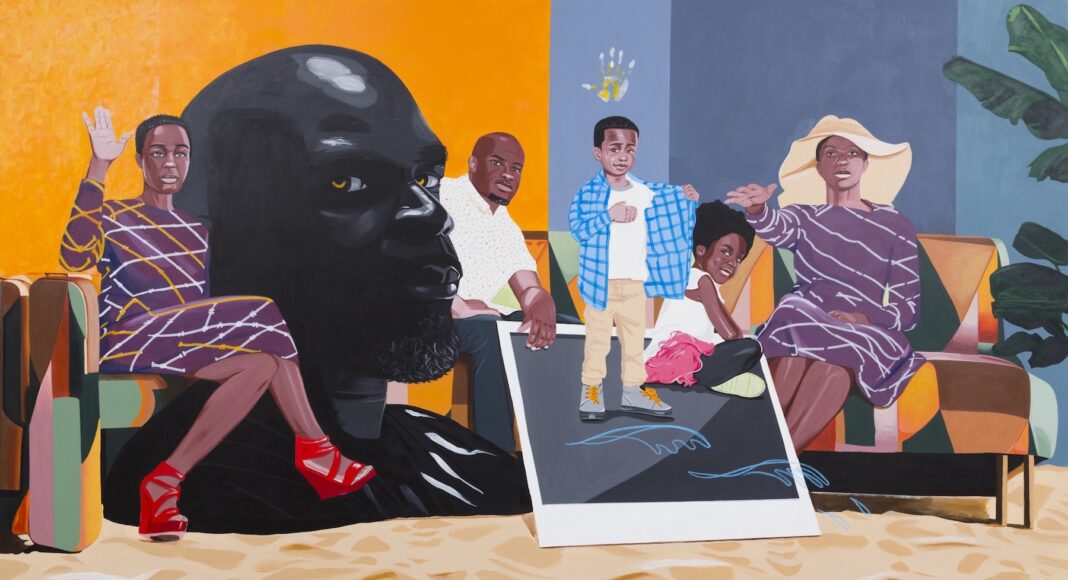In the center of the triptych a family poses alongside a Polaroid and a huge, dark bust of a man’s head. A little boy stands proudly between his sitting relatives, two handprints floating above his head—his father’s larger hand encircling the boy’s own.
For his second family portrait—a facade spanning eleven feet of wall on South First Street––Ghana-born, Detroit-based artist Conrad Egyir asked a family he’d known for years to sit. The poses are a combination of formal and relaxed: next to the boy, his sister sits with a grin, cross-legged and slouching, while to the left a mother raises her hand as if taking an oath. The parallel open hands are a perfect introduction to Egyir’s work, where the intimate and the official stand side-by-side, often sharing identical symbols.
Egyir’s newest exhibition, Chapters of Light, opened at San Jose’s Institute of Contemporary Art earlier this month. The facade, A Chapter of Love, was commissioned by ICA as part of an ongoing project to establish the museum as a visual landmark. A postage stamp affixed to the left panel of the facade sticks out above the top of ICA’s roof, as well as the top of the painting itself—a common three-dimensional element of the artist’s work.
Egyir’s world is punctuated with ephemera: stamps, binder tabs, notebook paper. These archival materials serve as “visual metaphors for migration,” he says, invoking the spectrum of paperwork and documentation required by both institutions of the state and the university (Egyir grew up in Accra, Ghana’s capital, and moved to the U.S. as a student).
Text is another recurring element in Egyir’s work, frequently appearing in English, Swahili and Twi, a West African dialect the artist names as his “local, native tongue.”
“I often use it to add an extra layer of a narrative,” he says. “In my MFA program, I was heavy on symbols and iconography from West Africa, but my colleagues had trouble understanding them visually so I had to find a way to use language to break that divide.”
Books also show up in many of the show’s paintings, some real, some invented. For “Mitchell’s Class,” the piece which graces the top of ICA’s webpage for the exhibition, Egyir asked his model (in this case, his studio assistant Mitchell) about his favorite books. The titles––Fred Moten’s Black & Blur and Ralph Ellison’s The Invisible Man––are clearly displayed, balancing atop the subject’s head.
Egyir says the placement is a nod to American photographer Paul Strand, whose early 1960s portrait of a young Ghanian woman, Anna Attinga Frafra, in the same pose came to represent the country’s early days of independence.
“We [Ghana] had just gained our independence, just got out of colonialism, and were inheriting, or trying to establish our own, literature and curriculum,” he says, of the iconic photo.
For Mitchell’s Class, Egyir elevates Strand’s personalization of history not just by naming his subject in the title (as Strand did), but by displaying Mitchell’s own literary canon. The sense of collaboration and agency is unique in an artist/model dynamic––particularly considering the treatment of Black subjects throughout Western art history.
In Mediums, the newest series in the exhibition, the books carry titles of concepts instead: “THE CREATOR / THE CREATURE / AND THE LAND,” reads one. These phrases, Egyir explains, entered his mind when he returned to Ghana after COVID-19 hit.
“Whenever I go back home, I go straight to the village. People ask me, ‘Why don’t you go to Accra?’ But there’s something very humbling about being in the village, going straight to the people, that a lot of people in cities have no experience with.”
Before emigrating, he’d spent a year in his family’s village, assisting the school his grandfather had founded there. (The archival motif represents a legacy of education, as well: Egyir comes from a family of teachers on both sides.)
“I had this longing to go back home and help him develop it into something larger, to set up a new curriculum…which played a part in the iconographies, textures, formal aspects of my paintings.”
It makes sense, then, that Egyir’s visual “curriculum” transcends boundaries of all kinds: the frames of his paintings, the divide between text and image, and the roof of the museum itself.
Conrad Egyir: Chapters of Light
Now showing, 12pm-5pm, Free
ICA, San Jose



